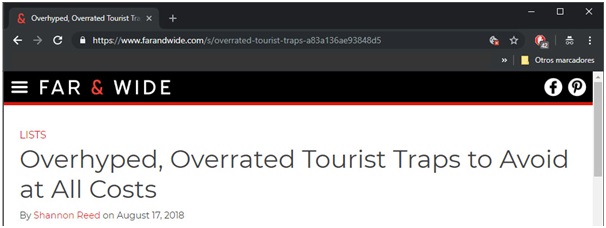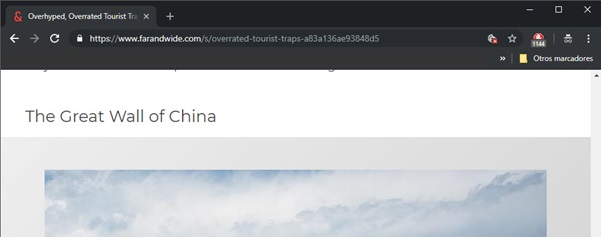The term Clickbait –literally, bait for clicks– refers to certain type of content that is distributed under a headline which creates high expectations, or which is defiant and seek to arouse the user’s curiosity or ghoulishness to click on the link.
Fake news or biased interpretations of updates or topics of interest are also considered Clickbait.
The headline or “bait” of this content usually goes with phrases such as “You won’t believe this”, “You’ll be extremely surprised”, “X group doesn’t want you to know about it” or other overstatements, out of context more often than not.
What is Clickbait for?
The main role of Clickbait is generating traffic to sites that make money out of advertising. It is usually some article that was optimized to be shared through the social networks, mostly on Facebook, where it’s easier to get viral.
Some websites include functions such as galleries (the typical article where you need to go from one page to the next in order to see all the pictures), slides, or even automatic updates of the page, which allows them to enlarge their advertising space.
To give you an idea of the amount of ads that just one Clickbait article may display, let’s take this one from Facebook as an example, with a promising link: “Overrated traps for tourists that you must avoid”. Up to the present, this content has been shared 3,123 times.

At opening the page, the ad-block detected 42 ads. 45 slides later (pretty disappointing, indeed), the counter displayed the amazing figure of 1,144 blocked ads.


Assuming that people who shared the article have gone through all the slides till the end, we get a shocking 3,572,712 available advertising spaces to make cash on PPC. In practice, this figure is most probably higher, since the page may get traffic from other sources too.
Clickbait can also be used in SEO and SEM campaigns.
This article may be helpful: How to boost your business growth through social media in an organic way
Which is the difference between Clickbait and Fake news?
Although they are not the same thing, it is very usual to associate Clickbait to Fake news, that is, to the dissemination of news that are not true, as both are biased digital strategies and far from ethical conduct.
Fake news are especially plentiful in periods sensitive for politics –like the eve of elections– or after a natural or human tragedy. However, it’s about different concepts serving different purposes, so they should not be mistaken for the other. Clickbait is not necessarily a lie, but it might contain misleading or manipulated content.
Is Clickbait bad?
To date there is a debate about how ethic it is to use clickbait to generate traffic, and there’s little consensus about it. However, it actually works and its use has been standardized.
What’s really bad about Clickbait are other habits linked to it, as Fake News and advertising abuse. With such extended results, even Facebook has implemented algorithms to reduce the impact of Clickbait since 2014.
Sites that usually generate Clickbait actually draw a lot of traffic and make profit thanks to the advertising spots, but nothing else. In practice, results are exactly all we do not want for our inbound marketing campaign.
Following the example above, we checked the statistics of FarAndWide from Alexa, and the results are bad: bounce rate is really high (it should be ideally 35%), time spent on the site is very short and most users won’t see more than one page before they leave.

You might also be interested in: What are CPC, CPM and CPA?
Who does Clickbait?
There are companies such as Taboola or Outbrain which specialize in making money out of this type of advertising.
Por otra parte, sitios como BuzzFeed, Upworthy, Vice, Cultura Colectiva y Badabun se han consagrado como los mayores productores de clickbait independientes, y generan suficiente tráfico para ser sitios bastante rentables.
Learn more about clickbait
Good or bad? Useful or useless? Should you use it or not? The last word is yours. If you want to learn more about this topic, check these resources we’ve selected for you.
- You Can’t Not Click: Weighing the Pros & Cons of Clickbait – from WordStream
- The frightening data behind clickbait – from The Startup
- Clickbait: Pros, Cons & How to Leverage Clickbait for SEO – from <Seo.co/>
- Why Clickbait Works (And Why You Should Do More of It) – from Neil Patel
- How Has Facebook’s Click Bait Rule Changed Internet Marketing? – from NorthCutt
- Use of clickbait in the online news media of the 28 EU member countries – from RLCS
- Bait shaming: an evolution in the battle against clickbait – De Tyler Hakes
Do you need help with your content?
There’s no need to resort to Clickbait to elaborate eye-catching content to drive a lot of traffic to your website. At Workana you’ll find the best independent professional writers, with loads of experience in several market niches, who will give your marketing campaign the boost it needs.
What is Workana?
We invite you to know Workana, the leading freelance marketplace. We’ve been working since 2012 to keep connecting companies and entrepreneurs with remote workers of the most diverse specialty areas.





